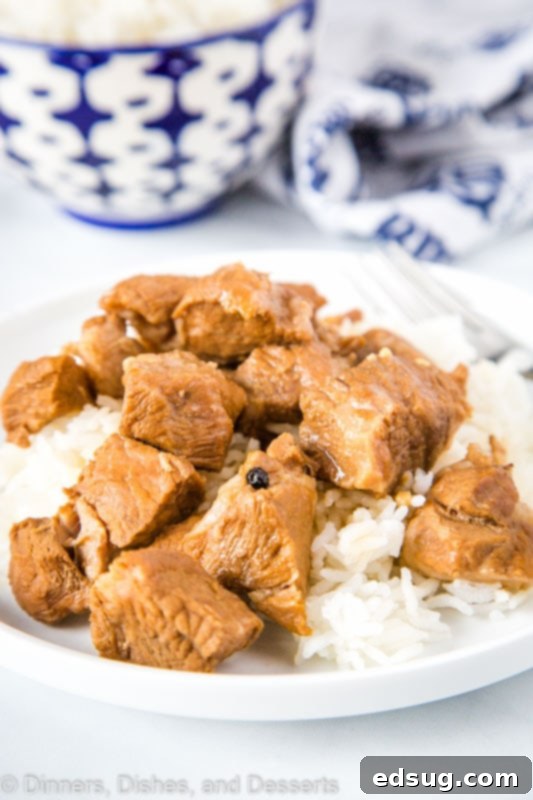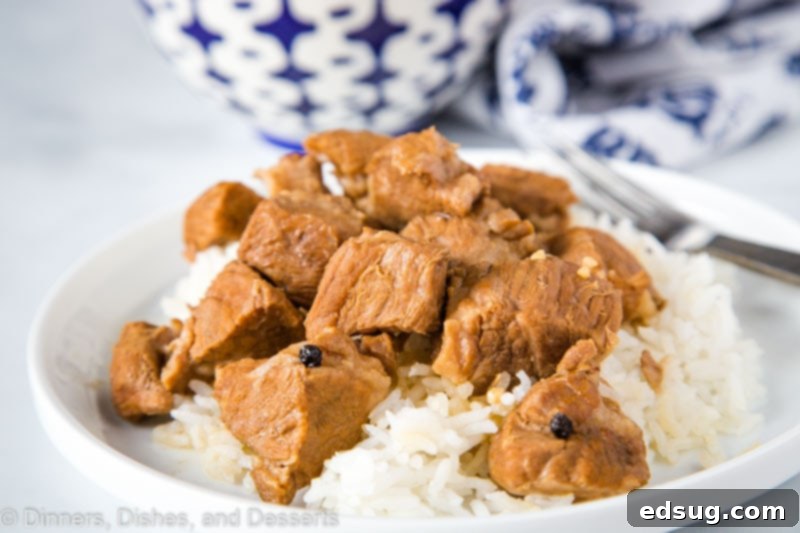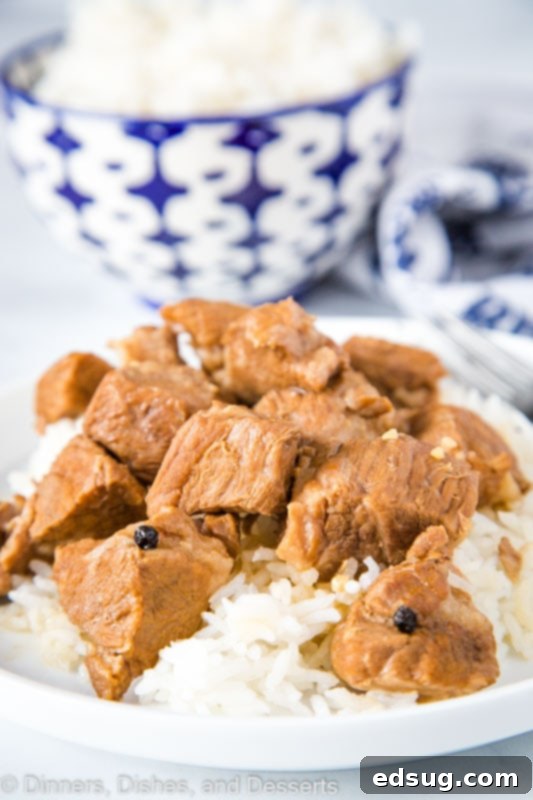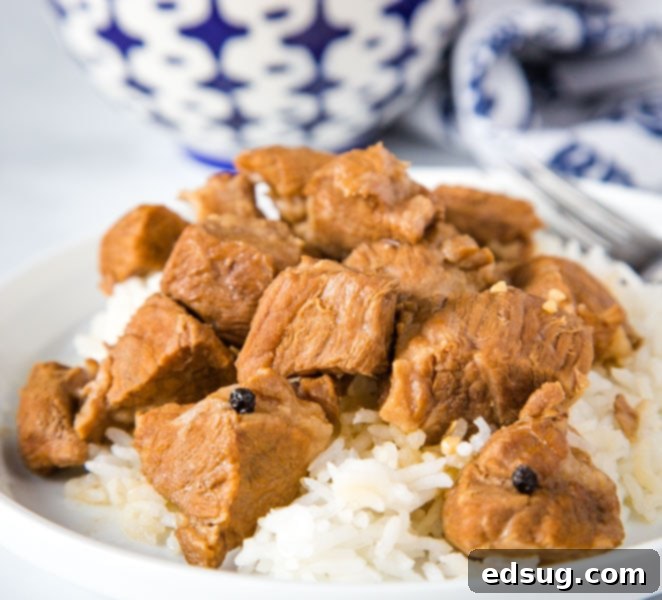Authentic Filipino Pork Adobo Recipe: Tender, Flavorful & Easy to Make
Embark on a culinary journey to the Philippines with this incredible Pork Adobo recipe. A true staple of Filipino cuisine, Adobo is celebrated for its irresistible balance of savory, tangy, and subtly sweet flavors, all infused into incredibly tender meat. While there are countless variations across the archipelago, this pork rendition offers a hearty, satisfying meal that’s surprisingly simple to prepare. If you’re looking to expand your international cooking repertoire beyond familiar Asian dishes, look no further than this rich and aromatic stew. It’s a dish that truly captivates the senses and promises a delightful experience, especially when served steaming hot over a bed of fluffy white rice.
Exploring the diverse culinary landscape of the world has always been a passion, but Filipino cuisine, with its unique blend of influences, is one we haven’t delved into extensively until now. While I’ve ventured into dishes like Vietnamese Egg Rolls on the blog, the distinctive flavors of the Philippines remained a delightful mystery. Before discovering this particular pork adobo recipe, my only encounters with Adobo had been the chicken version, which always left me wanting more of its rich, complex, and tangy sauce. The depth of flavor is truly addicting!

My motivation to finally master this dish came from an unforgettable experience on a recent cruise. One of our wonderful waitstaff, hailing from the Philippines, shared captivating stories about Adobo and passionately described its unparalleled deliciousness. Her enthusiasm was contagious! As soon as we returned home, I was determined to recreate this culinary masterpiece, and I’m thrilled to report that it exceeded all expectations. The dish truly did not disappoint and has since become a beloved addition to our family’s meal rotation.
What is Filipino Adobo? A Culinary Icon
Filipino Adobo is not just a dish; it’s a cooking process, a national treasure, and a symbol of Filipino culinary identity. At its heart, Adobo involves stewing meat (most commonly pork or chicken, but also seafood or vegetables) in a distinctive combination of soy sauce, vinegar, crushed garlic, and black peppercorns, often with bay leaves. This simple yet powerful blend of ingredients creates a deep, savory, and tangy sauce that tenderizes the meat as it slowly cooks.
The origins of Adobo date back to pre-colonial times in the Philippines, where locals used vinegar and salt as a preservation method for food in a tropical climate. When the Spanish arrived, they observed this cooking technique and named it “adobar,” which means “to marinate” or “to season.” Over centuries, this method evolved, incorporating soy sauce (introduced by Chinese traders) and other spices, to become the beloved dish we know today. Each region, and often each family, has its own cherished version, making Adobo a dish with endless delightful variations.
The magic of Adobo lies in its long, slow cooking. As the meat simmers in the acidic vinegar and salty soy sauce, it becomes incredibly tender and absorbs all the rich flavors, resulting in a dish that is both comforting and intensely satisfying. The sauce thickens beautifully, coating every piece of meat, and is absolutely perfect for spooning over steamed rice, allowing the grains to soak up every drop of its rich goodness.

Why Choose Pork for Adobo?
While chicken adobo is arguably the most common and widely recognized version, pork adobo holds a special place in the hearts of many, and for good reason. Pork, particularly fattier cuts like pork butt or pork shoulder, lends itself exceptionally well to the slow-cooking process inherent in Adobo. As it simmers, the fat renders down, contributing an incredible richness and depth to the sauce that is unparalleled. This results in unbelievably tender, melt-in-your-mouth pieces of pork that are bursting with flavor.
The texture of pork adobo is often described as more substantial and satisfying than its chicken counterpart. The cuts of pork absorb the savory and tangy marinade beautifully, becoming incredibly succulent and juicy. If you appreciate rich, fall-apart tender meat combined with a deeply flavorful sauce, then pork adobo is an absolute must-try. It’s a truly comforting dish that showcases the versatility and deliciousness of pork when prepared with the traditional Adobo method.
Essential Pork Adobo Ingredients
One of the beauties of this Filipino Pork Adobo recipe is its reliance on simple, accessible ingredients that come together to create something truly extraordinary. You’ll likely find most of these staples already in your pantry!
- Pork Butt or Pork Shoulder: These cuts are ideal for Adobo due to their fat content and connective tissues, which break down during slow cooking, resulting in incredibly tender and flavorful meat. Cut into 2-inch cubes for optimal searing and even cooking.
- Soy Sauce: The cornerstone of Adobo, providing a deep, umami-rich, and salty base for the sauce. Use a good quality regular (not light or low-sodium, unless adjusting for dietary needs) soy sauce for authentic flavor.
- White Vinegar: Crucial for that characteristic tangy kick in Adobo. It also helps to tenderize the pork. Don’t be tempted to stir it much right after adding; let it come to a boil and cook off its raw acidity.
- Vegetable Oil: Used for browning the pork, which helps to develop a rich, caramelized flavor and texture on the exterior of the meat before it simmers in the sauce.
- Garlic: A generous amount of minced garlic is essential. It infuses the entire dish with its pungent, aromatic, and distinctly savory notes, complementing the soy sauce and vinegar beautifully.
- Bay Leaves: These fragrant leaves add a subtle, almost floral, herbaceous note to the Adobo, contributing to its complex aroma and rounding out the overall flavor profile.
- Peppercorns: Whole black peppercorns are traditionally used, offering a mild, earthy spiciness that is foundational to Adobo’s taste. Their subtle heat balances the tang and savoriness.
- Water: Used to thin out the sauce slightly and ensure there’s enough liquid for the pork to simmer and become fork-tender. It also helps balance the intensity of the soy sauce and vinegar.
As you can see, the list of ingredients for this pork adobo recipe is refreshingly straightforward. There’s absolutely no need to be intimidated by this dish; its magic truly comes from the way these basic components interact and transform over time. The simplicity of the ingredients belies the complexity and depth of flavor you’ll achieve.

Step-by-Step Guide: How to Make Pork Adobo
Making delicious Pork Adobo is a patient process, but the steps themselves are quite simple and forgiving. The key is to allow ample time for the flavors to meld and the pork to achieve that desirable fall-apart tenderness. Follow these steps for a truly authentic and satisfying meal:
- Sear the Pork to Perfection: The initial step is to thoroughly sear the pork. I used pork butt, which I cut into manageable 2-inch cubes. Heat a large, heavy-bottomed pot or Dutch oven over high heat and add your vegetable oil. Once shimmering, add the pork in batches, ensuring not to overcrowd the pot. Crowding will steam the meat instead of browning it. Sear each batch until beautifully browned on all sides. This crucial step develops a deep, rich flavor through the Maillard reaction, adding a layer of complexity to the final dish. Remove browned pork and set aside.
- Simmer for Tenderization and Flavor Infusion: Once all the pork is seared and returned to the pot, it’s time to build the iconic Adobo sauce. Add the soy sauce, white vinegar, minced garlic, bay leaves, black peppercorns, and water to the pot with the browned pork. Bring the mixture to a rolling boil, then immediately reduce the heat to a gentle simmer. Cover the pot and let it cook for at least one hour. This slow, gentle cooking process is vital; it allows the connective tissues in the pork to break down, rendering the meat incredibly tender and juicy, while also allowing it to fully absorb the rich flavors of the sauce.
- Reduce the Sauce for Intensity: After the initial hour of simmering with the lid on, remove the lid. Continue to simmer the Adobo, uncovered, for another 30 to 45 minutes, or until the sauce has reduced significantly and thickened to your desired consistency. As the liquid evaporates, the flavors become more concentrated and intense, creating a rich, glossy, and deeply satisfying sauce that perfectly coats the tender pork. Taste and adjust seasoning if necessary, though the soy sauce usually provides enough salt.
- Serve with Steamed Rice: Adobo is unequivocally best served over freshly cooked white rice. The rice acts as a perfect canvas, soaking up every drop of the savory, tangy, and aromatic sauce, making each bite a harmonious blend of flavors and textures. The simplicity of the rice truly allows the complex flavors of the Adobo to shine.

If you’re eager to venture beyond familiar Asian dishes like Chicken Lo Mein, this Pork Adobo is the perfect recipe to do it with. It requires a bit of patience to allow the sauce to truly cook down and infuse the meat with its incredible flavor, but I assure you, it is immensely worth every moment. The depth of taste and the tenderness of the pork are simply unparalleled. Plus, a fantastic bonus: the leftovers are absolutely amazing, often even better the next day as the flavors continue to meld and deepen!
Tips for the Perfect Pork Adobo
- Don’t Rush the Simmer: The key to truly tender pork and a deeply flavorful sauce is time. Resist the urge to crank up the heat or shorten the simmering duration. Low and slow is the way to go.
- Quality Ingredients Matter: While simple, using good quality soy sauce and fresh garlic can make a noticeable difference in the final taste of your Adobo.
- Taste and Adjust: Towards the end of the cooking process, taste the sauce. If it’s too salty, add a splash more water. If it needs more tang, a tiny bit more vinegar can be added (though traditionally, the vinegar is added at the start and its raw edge cooked off). If you want a touch of sweetness, a teaspoon of brown sugar can be stirred in to balance the flavors.
- Crispy Pork Skin (Optional): For an extra layer of texture, after the adobo is cooked, you can remove the pork pieces and pan-fry or air-fry them briefly until the edges are slightly crispy. Then toss them back into the reduced sauce.
- Serve It Right: Always serve Adobo with plenty of steamed white rice. The rice acts as a perfect foil, soaking up the rich sauce. Some people also enjoy a side of blanched or steamed vegetables to add freshness.
- Leftovers are Gold: Adobo is one of those dishes that often tastes even better the next day. The flavors have more time to deepen and develop, making it an excellent meal prep option.
Exploring Adobo Variations
While pork adobo is undeniably delicious, the world of Adobo is vast and varied. Once you’ve mastered this recipe, don’t hesitate to experiment!
- Chicken Adobo: Perhaps the most famous version, often made with bone-in chicken pieces, resulting in a slightly lighter but equally flavorful dish.
- Adobong Pusit (Squid Adobo): A unique and savory take featuring squid cooked in the classic adobo sauce, often with a hint of its own ink for a darker, richer color and oceanic flavor.
- Adobong Kangkong (Water Spinach Adobo): A delicious vegetarian option where water spinach (or other leafy greens) are cooked in the adobo base, often with a touch of fermented shrimp paste (bagoong) for added depth.
- Adobo Flakes: A popular way to enjoy leftover adobo, where the meat is shredded and pan-fried until crispy, perfect for breakfast or snacks.
Each variation brings its own texture and subtle flavor nuances, showcasing the incredible versatility of the Adobo cooking method.
Storing and Reheating Your Adobo
Adobo is an excellent dish for meal prepping due to its incredible flavor that often improves with time. Store any leftover Pork Adobo in an airtight container in the refrigerator for up to 3-4 days. To reheat, gently warm it on the stovetop over medium-low heat until heated through, adding a splash of water if the sauce has become too thick. Adobo also freezes well for up to 2-3 months. Thaw overnight in the refrigerator before reheating.
This Pork Adobo recipe truly demonstrates how a handful of basic ingredients, when combined with the right technique, can create an incredibly satisfying and exotic meal. You can take your taste buds on a journey around the world for dinner without even needing to visit a specialty grocery store for obscure ingredients. These are precisely the kind of meals that become cherished favorites in any kitchen – easy to make, deeply flavorful, and universally appealing!

More Delicious Dinner Recipes
- Slow Cooker Pork Roast
- Lemon Garlic Pork Chops
- Instant Pot Pulled Pork
- Smothered Pork Chops
- Crispy Pork Cutlet
- Oven Baked Pork Chops

Pork Adobo Recipe
Pin Recipe
Rate Recipe
Print Recipe
Equipment
-
Pot and Pan Set
Ingredients
- 2 pounds pork butt or pork shoulder, cut into 2 inch cubes
- 2 Tablespoons vegetable oil
- 1/2 cup soy sauce
- 1/2 cup white vinegar
- 3 cloves garlic, minced
- 2 bay leaves
- 1 teaspoon black peppercorns
- 1/2 cup water
Instructions
-
In a large pot, heat oil over high heat. Add the pork butt or shoulder, cut into 2-inch cubes, in batches to brown on all sides. Do not overcrowd the pot; sear in multiple batches if necessary to ensure good browning.
-
Once all the meat is browned, return all the meat to the pot. Add the soy sauce, white vinegar, minced garlic, bay leaves, black peppercorns, and water. Bring the mixture to a boil. Cover the pot, reduce the heat to a simmer, and cook for 1 hour.
-
After 1 hour, remove the lid and continue to simmer for another 30 to 45 minutes, or until the liquid has reduced by half and the sauce has thickened and coated the pork beautifully. The pork should be fork-tender.
-
Serve your delicious Pork Adobo hot over freshly cooked white rice. Enjoy!
Nutrition
Nutrition information is automatically calculated, so should only be used as an approximation.
Additional Info
Like this recipe? Leave a comment below!
I created a fun group on Facebook, and I would love for you to join us! It’s a place where you can share YOUR favorite recipes, ask questions, and see what’s new at Dinners, Dishes and Desserts (so that you never miss a new recipe)!
Be sure to follow me on Instagram and tag #dinnersdishes so I can see all the wonderful DINNERS, DISHES, AND DESSERTS recipes YOU make!
Be sure to follow me on my social media, so you never miss a post!
Facebook | Twitter | Pinterest | Instagram
